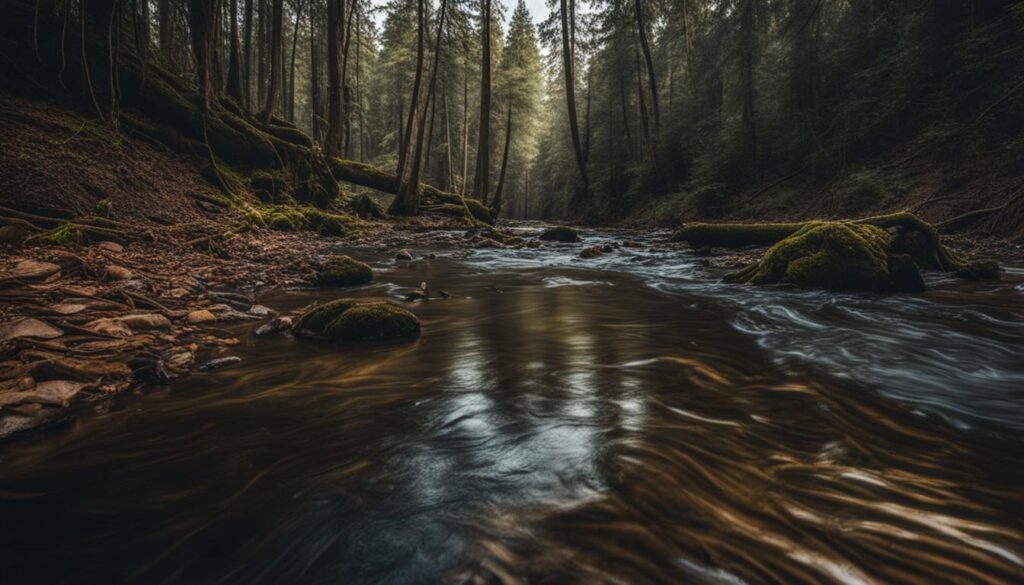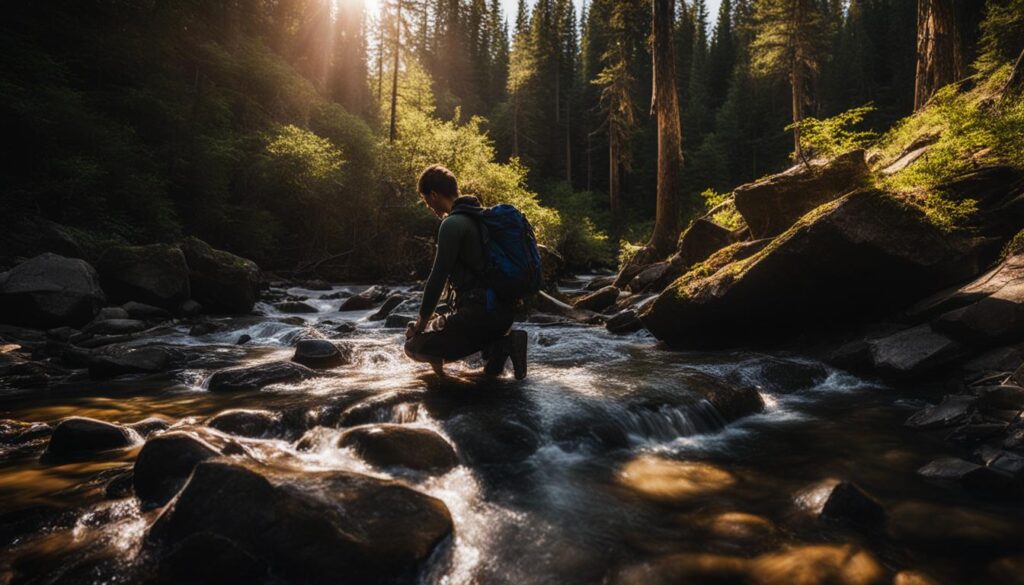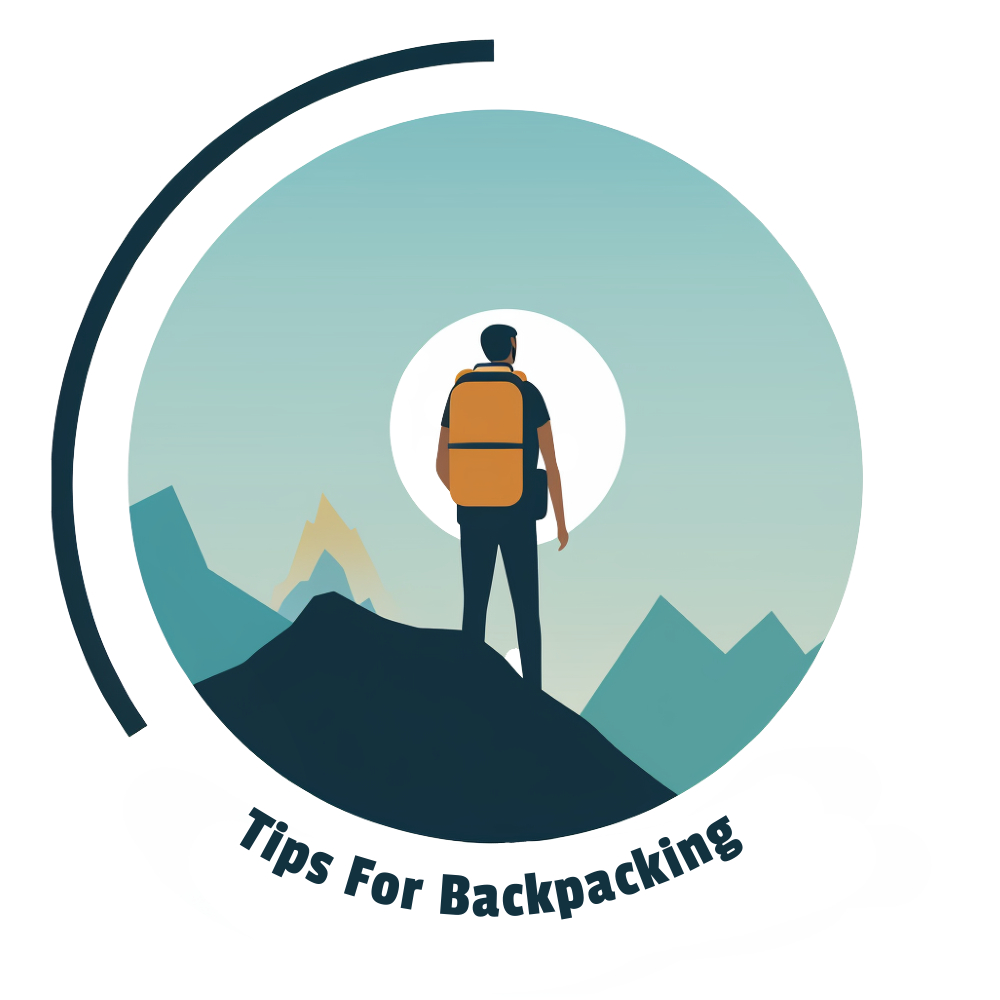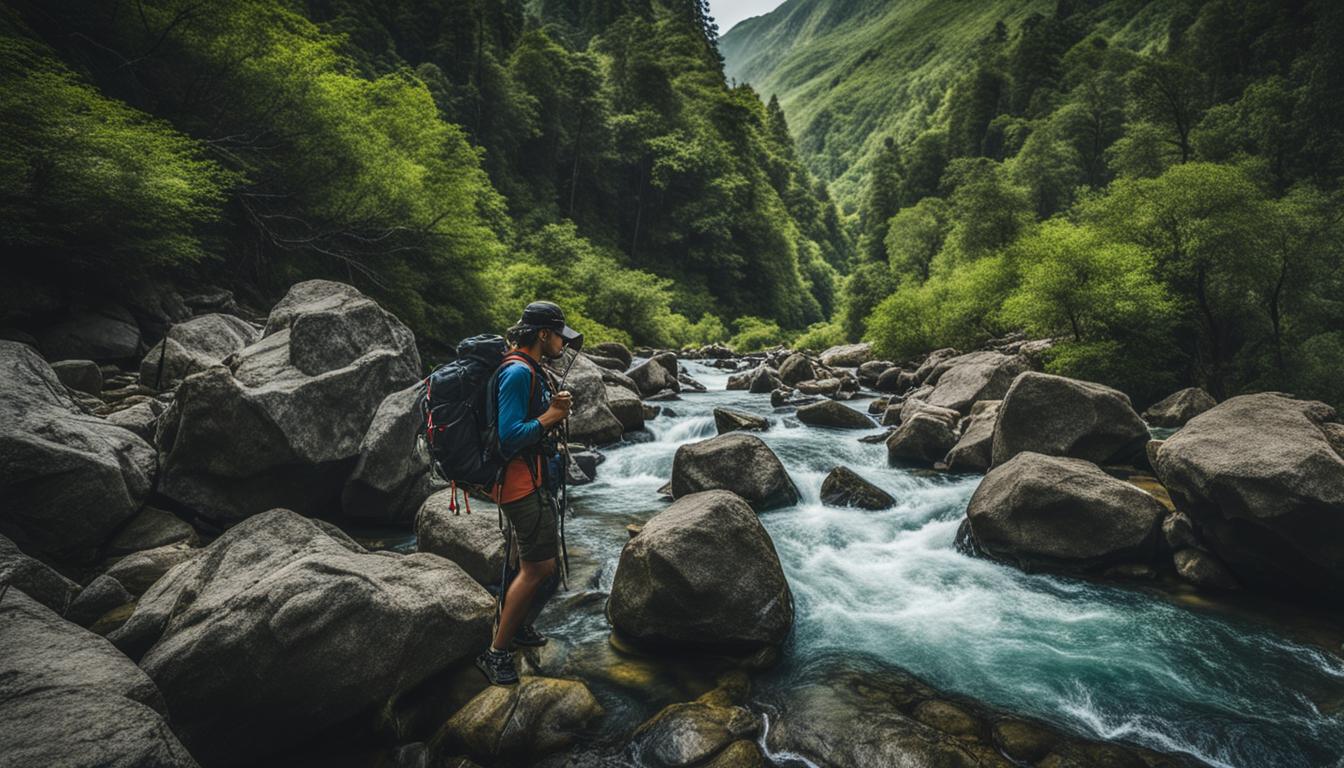Hey there fellow adventurers! As an avid backpacker, I know just how essential water is for a successful and safe journey in the wilderness. In this article, I’ll share my insider tips on finding, treating, and storing water while backpacking, so you can stay hydrated and healthy on the trail.
Key Takeaways:
- Knowing how to source safe water while backpacking is crucial for staying hydrated and avoiding waterborne illnesses.
- Understanding the risks of dehydration and water contamination can help you prioritize water sourcing and treatment.
- Resources like topographic maps, aerial photos, and guidebooks are invaluable in finding reliable water sources on the trail.
- When planning your backpacking route, consider the availability of water sources and estimate your water consumption to ensure you have enough supply.
- Boiling, chemical treatment, and filtration are the primary methods of water purification for backpackers, and it’s important to have backup options.
The Importance of Clean Water in the Backcountry
In the backcountry, finding a reliable source of clean water is essential for backpackers to stay hydrated and healthy during their outdoor adventures. With the lack of readily available water and the physical exertion of hiking, it is easy to become dehydrated. As an outdoorsperson, I know the importance of consuming enough water to stay properly hydrated.
When venturing into the backcountry, backpackers often rely on natural water sources such as rivers, creeks, and springs to replenish their water supply. However, it is crucial to be able to treat these water sources for potential contaminants. We can’t risk drinking water that could be contaminated with bacteria, viruses, or parasites, as it can lead to waterborne illnesses and other health issues.
As a backpacker, I understand the need to remain self-sufficient and be prepared to treat water while on the trail. It is important to carry water treatment methods such as boiling, chemical treatment, or filtration to ensure the water we consume is safe. By taking these precautions and being conscious of our water consumption, we can minimize the risks associated with dehydration and contamination in the backcountry.
Backcountry Water Sources
When backpacking in the backcountry, it is crucial to know where to find reliable water sources. Some common backcountry water sources include:
- Streams and rivers: These are often easily accessible and provide a continuous flow of water.
- Creeks and springs: These sources may require some navigation but can provide clean and fresh water.
- Lakes and ponds: These larger bodies of water can be used for drinking water, but it is advisable to use a water treatment method to ensure safety.
It is important to note that the availability of water sources can vary depending on the season, weather conditions, and location. Therefore, it is essential to plan ahead and gather information from reliable sources such as topographic maps, guidebooks, or park rangers to identify the best water sources along your hiking route.
Water Consumption for Outdoorspeople
As an outdoorsperson, I understand the importance of staying properly hydrated while hiking in the backcountry. The general rule of thumb for water consumption is to drink at least one quart of water per hour of moderate activity. However, individual needs may vary based on factors such as body size, exertion level, and environmental conditions.
It is crucial to listen to our bodies and drink water regularly throughout the day. Thirst is not always an accurate indicator of hydration, so I make it a point to sip water frequently, even if I don’t feel intensely thirsty. By maintaining proper hydration, I can avoid the negative effects of dehydration and ensure a safe and enjoyable backpacking experience.
Risks of Dehydration & Contamination

When backpacking in the backcountry, there are significant risks associated with dehydration and water contamination. Dehydration occurs when the body loses more fluid than it takes in, leading to a fluid deficit that can have serious consequences for backpackers. Even a 2% fluid deficit can result in reduced cognitive performance and symptoms such as fatigue, dizziness, and confusion. It is essential to prioritize hydration and ensure an adequate intake of water while on the trail.
However, water sources in the backcountry can be contaminated with harmful pathogens, making it crucial for backpackers to be aware of the risks and take necessary precautions. Waterborne illnesses such as E. coli, Giardia, and Cryptosporidium can be contracted by ingesting contaminated water, leading to severe gastrointestinal symptoms and potentially life-threatening complications. The limited access to medical help in remote areas exacerbates the risk of waterborne illness, making prevention through water treatment methods even more critical.
“Proper hydration is essential for backpackers to stay healthy and safe on the trail. The risk of dehydration and waterborne illnesses should not be underestimated.”
To minimize the risk of dehydration and waterborne illness, it is recommended to treat all water sources in the backcountry. Boiling water is the most effective method, as it kills all pathogens, but it may not always be feasible due to limited fuel or time. Backpackers can also use chemical treatments, such as chlorine or iodine tablets, to destroy or neutralize pathogens. Filtration systems can be used to strain out bacteria and parasites, but they may not be effective against viruses. It is advisable to carry backup water treatment tools and be prepared for unexpected situations.
In conclusion, the risks of dehydration and water contamination are significant while backpacking in the backcountry. It is crucial for backpackers to prioritize hydration and be knowledgeable about water treatment methods to ensure their safety and well-being on the trail. By taking necessary precautions and utilizing appropriate water treatment tools, backpackers can minimize the risks associated with dehydration and waterborne illnesses, allowing for a more enjoyable and worry-free backpacking experience.
Water Sourcing in Backpacking: Insider Tips for Finding, Treating, and Storing Water on the Trail
When embarking on a backpacking adventure, finding reliable water sources is essential for staying hydrated and safe. As a backpacker, I rely on various resources to locate water on the trail. One effective method is using topographic maps. These maps provide valuable information about the terrain, including rivers, streams, and lakes, which can be potential water sources. By studying the topography, I can determine the proximity and accessibility of water along my route. Additionally, aerial photos offer a bird’s-eye view of the landscape, helping me identify potential water sources that may not be evident on traditional maps.
Guidebooks are also invaluable tools for backpackers. They often include detailed information about water sources in specific areas, highlighting reliable springs or creeks. These guidebooks are compiled by experienced hikers who have already explored the trails, so their insights are highly trusted. I make sure to consult guidebooks that are up-to-date to ensure accurate information about water availability. Additionally, speaking to park rangers before my trip provides firsthand knowledge about the current state of water sources in the area.
Table: Comparison of Water Source Resources
| Resource | Advantages | Disadvantages |
|---|---|---|
| Topographic maps | – Provide detailed information about the terrain and water sources – Indicate proximity and accessibility of water |
– May not include recent changes in the landscape – Requires basic navigation skills |
| Aerial photos | – Offer a visual overview of the landscape – Reveal hidden or lesser-known water sources |
– Limited availability of current and high-resolution photos – Difficult to interpret for novice backpackers |
| Guidebooks | – Compiled by experienced hikers with firsthand knowledge – Provide detailed information about water sources in specific areas |
– Information may become outdated – Limited availability for remote or lesser-known trails |
As a seasoned backpacker, I have learned the importance of gathering as much information as possible about water sources on the trail. By utilizing topographic maps, aerial photos, and guidebooks, I can plan my route effectively and ensure a reliable water supply throughout my journey.
Remember, finding water sources is just the beginning. It is crucial to treat the water before consuming it to eliminate any potential contaminants. In the next section, we will explore different water treatment methods that backpackers can employ to ensure their safety and well-being.
Route-Planning With Water in Mind

When embarking on a multiday backpacking trip, it is essential to carefully plan the route with water supply in mind. Proper hydration is crucial to ensure the safety and well-being of backpackers on the trail. Estimating water needs and strategizing for regular access to water sources are key considerations for a successful trip.
First and foremost, it is important to calculate water consumption accurately. Factors such as distance, elevation gain, weather conditions, and individual exertion levels all impact how much water a backpacker should carry. A general guideline is to consume one liter of water per hour of hiking, but this can vary depending on the terrain and personal needs.
When structuring the route, it is advisable to identify and map out reliable water sources along the way. This can be done by consulting guidebooks, topographic maps, and seeking information from experienced backpackers or park rangers. Keep in mind that water availability can change with the seasons, so it is crucial to update and verify your water sources before setting off on the trail.
Consider the layout of water sources in relation to your planned itinerary. If there are long stretches without access to water, it may be wise to break up those sections and plan shorter hiking days to ensure easier access to water sources. Additionally, take note of the elevation of water sources, as they may be located at higher or lower points along the trail. This information will help in planning your camping spots and water resupply points strategically.
Table: Estimated Water Consumption
| Activity Level | Water Consumption per Hour |
|---|---|
| Light | 0.5 liters |
| Moderate | 1 liter |
| Intense | 1.5 liters |
Remember that water is heavy, so carrying excess amounts can be burdensome. By carefully planning your route with water sources in mind, you can minimize the weight of your backpack while ensuring you have enough water to stay hydrated throughout your adventure. With proper preparation, you can enjoy your backpacking trip while staying safe and well-hydrated.
Backpacking Water Treatment Methods
When venturing into the backcountry, it is vital to have a reliable method for treating water to ensure your health and safety. There are three primary methods for backpacking water purification: boiling, chemical treatment, and filtration. Each method has its advantages and considerations, and many experienced backpackers use a combination of these approaches based on their specific needs and circumstances.
Boiling
Boiling water is the most effective method of purification, as it kills all pathogens that may be present. To use this method, simply bring the water to a rolling boil for at least one minute (or three minutes at high altitudes) to ensure that all harmful bacteria, viruses, and protozoa are eliminated. Boiling requires a heat source, such as a stove or campfire, and a pot or container to hold the water.
Chemical Treatment
Chemical treatment involves the use of disinfectants, such as chlorine dioxide tablets or iodine drops, to kill or neutralize pathogens in the water. These chemicals are typically added to the water and allowed to sit for a specified period, usually around 15-30 minutes, before drinking. It is important to follow the instructions carefully, as different products may have specific dosage requirements and contact times.
Filtration
Filtration is a popular method for treating water on the trail, as it removes larger particles, sediment, and many microorganisms from the water. Backpacking water filters typically use a combination of mechanical filtration and chemical processes to remove impurities. These filters can vary in size and complexity, from small handheld devices to larger gravity-fed systems. It’s important to choose a filter that meets your specific needs, taking into account factors such as flow rate, weight, and filter lifespan.
It is important to note that no single method is foolproof, and their effectiveness may vary depending on the specific contaminants present in the water. It is advisable to have backup water treatment tools, such as water purification tablets or an extra filter, in case the primary method fails or is not suitable for the water source you encounter on the trail.
| Purification Method | Advantages | Considerations |
|---|---|---|
| Boiling | – Effectively kills all pathogens – No additional chemicals required |
– Requires a heat source and container – Time-consuming process |
| Chemical Treatment | – Lightweight and portable – Can treat a large volume of water |
– May leave a residual taste or smell – Some chemicals may have specific dosage requirements |
| Filtration | – Removes sediment and larger particles – Can improve water taste |
– Varies in size, weight, and filtration speed – Some filters may require periodic maintenance or replacement |
By using a combination of boiling, chemical treatment, and filtration, backpackers can ensure that they have access to safe and clean drinking water while exploring the wilderness. It is important to research and understand the specific water sources in your intended backpacking area, as well as any potential contaminants that may be present. With proper preparation and the right water treatment methods, you can enjoy your backpacking adventure while staying hydrated and healthy.
Conclusion
After exploring the importance of clean water in the backcountry and the risks of dehydration and contamination, it is clear that proper water sourcing, treatment, and management are essential for backpackers. To ensure a safe and enjoyable backpacking experience, it is crucial to have a well-thought-out water carry plan.
I start by estimating my water needs based on factors such as the length and difficulty of the trail, weather conditions, and personal hydration levels. This allows me to determine how much water I need to carry and where I can replenish my supply along the route. Planning ahead and studying topographic maps and guidebooks help me identify reliable water sources.
Proper hydration is key to staying healthy and energized on the trail. I make sure to drink enough water before, during, and after hiking to prevent dehydration. I pay attention to the signs of dehydration, such as dry mouth, headache, and fatigue, and take regular breaks to rest and hydrate.
When it comes to carrying water, I opt for methods that are convenient and efficient. One option is using soft bottles that are lightweight and easy to pack. Another popular choice is hydration reservoirs, which allow me to drink water on the go without having to stop and take out a bottle. Whichever method I choose, I always carry enough water to last me between water sources, especially in areas where water is scarce.
– What Are the Best Water Sourcing Methods for Backpackers in Emergency Situations?
When in the wilderness, emergency water sourcing tips for backpackers are crucial. Boiling water from streams or using a portable water filter can help prevent dehydration. Additionally, collecting rainwater or utilizing UV water purifiers are effective methods for obtaining clean water in dire situations.
FAQ
How much water should I drink while backpacking?
A general rule of thumb is to drink one quart of water per hour to stay hydrated. However, individual water needs may vary based on factors such as climate, exertion level, and body size.
How can I find water sources on the trail?
You can use resources such as topographic maps, aerial photos, guidebooks, and information from park rangers to locate water sources. These sources can provide valuable information on the location and quality of water sources in a given area.
What are the risks of dehydration and water contamination while backpacking?
Dehydration can lead to reduced cognitive performance and other symptoms even with a fluid deficit as small as 2%. Contaminated water can cause illnesses such as E. coli, Giardia, and Cryptosporidium, which can be life-threatening in the backcountry due to limited access to medical help.
What are the primary methods of water treatment for backpackers?
The three primary methods of water treatment for backpackers are boiling, chemical treatment, and filtration. Boiling water is the most effective method as it kills all pathogens. Filtration strains out pathogens, while chemical treatment kills or destroys them.
How should I plan my route to ensure access to water sources?
When planning a multiday backpacking trip, consider estimating your water consumption and the layout of water sources along the route. It may be necessary to split long stretches of trail into multiple days to allow for easier access to water. Factors such as elevation and distance from water sources should be taken into account.

